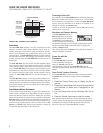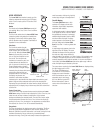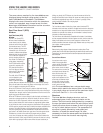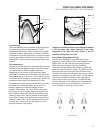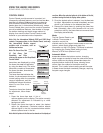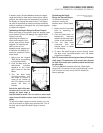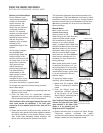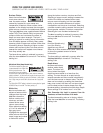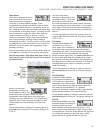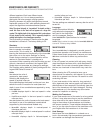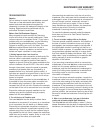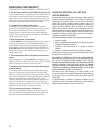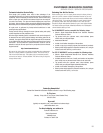
TROUBLESHOOTING
Repairs
Do not attempt to repair the LEGEND 3000 SERIES yourself.
There are no user-serviceable parts inside, and
special tools and techniques are required for
reassembly to ensure the waterproof integrity of the
housing. Repairs should be performed only by
authorized Techsonic technicians.
Before You Call Customer Support
Many requests for repair received by Techsonic
involve units that do not actually need repair. These
units are returned “no problem found.” If you have a
problem with your
LEGEND 3000 SERIES, use the following
troubleshooting guide before calling Customer
Support or sending your unit in for repair. The LEGEND
3000 SERIES contains several tools that can aid in
determining if there is a problem, as well as how to
isolate and repair a problem in many cases.
1. Nothing happens when I turn the unit on.
Check the power cable connection at both ends. Be
sure the cable is connected correctly to a reliable
power source—red lead to positive, black lead to
negative or ground. Ensure the power available at the
mount is between 10 and 20 VDC. If the unit is wired
through a fuse panel, ensure the panel is powered;
accessory fuse panels often are controlled by a
separate switch or by the boat’s ignition switch. A
fuse also can appear to be good when in fact it is not.
Check the fuse with a tester or replace it with a fuse
known to be good.
Check the power connection to the LEGEND 3000 SERIES. It
is possible to force the power cable connector into
the collector plug incorrectly. If the connector is
reversed, the unit will not work. Examine the contacts
on the back of the unit to ensure there is no corrosion.
Ensure the cables are properly installed into the
collector plug and the collector plug is properly
seated into the LEGEND 3000 SERIES.
2. The unit starts up in Simulator mode.
The L
EGEND 3000 SERIES
has the ability to detect that a
transducer is connected. If, at power up, a transducer
is not connected, the unit starts up in S
IMULATOR
mode.
Ensure that an appropriate transducer connector is
used and the connector is positioned correctly in the
collector plug. Also, be sure that the collector plug is
fully-seated into the unit. Next, inspect the transducer
cable from end to end for breaks, kinks, or cuts in the
outer casing of the cable, and repair after
disconnecting the cable from both the unit and the
transducer. Also, make sure that the transducer is fully
submerged in water. If the transducer is connected to
the unit through a switch, temporarily connect it
directly to the unit and try again. If none of these
items identifies an obvious problem, the transducer
itself may be at fault. Be sure to include the
transducer if returning the unit for repair.
To override the S
IMULATOR
manually, select the S
IMULATOR
C
ONTROL PANEL
and turn to O
FF
. See Control Panels for
more information.
3. There is no bottom reading visible on the display.
There are several possible causes for this condition. If
the loss of bottom information occurs only at high
boat speeds, the transducer needs to be adjusted. If
the digital depth readout is working but there is no
bottom visible on-screen, it is possible that the depth
range has been adjusted manually to a range lower
than that needed to display the bottom. Also, in very
deep water, it may be necessary to increase the GAIN
setting manually in order to maintain a graphic
depiction of the bottom.
If you are using a transducer switch to connect two
transducers to the L
EGEND 3000 SERIES
, make sure that the
switch is in the correct position to connect a
transducer, and that the transducer is submerged in
water. (If a trolling motor transducer is selected and
the trolling motor is out of the water, no sonar
information will appear.)
If none of the above solves the problem, inspect the
transducer cable from end to end for breaks, kinks, or
cuts in the outer casing of the cable, and repair after
disconnecting the cable from both the unit and the
transducer. If the transducer is connected to the unit
through a switch, temporarily connect it directly to the
unit and try again. If none of these items identifies an
obvious problem, the transducer itself may be at fault.
Be sure to include the transducer if returning the unit
for repair.
4. When in very shallow water, I get gaps in the bottom
reading and inconsistent digital depth indications.
The L
EGEND
3000 S
ERIES
will work reliably in water 2' (.6m) or
deeper. Remember that the depth is measured from the
transducer, not necessarily from the surface of the water
.
13
MAINTENANCE AND WARRANTY
TROUBLESHOOTING




